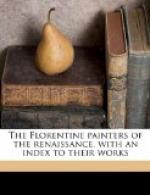his genius, and that skill
is art. This,
alas, has at all times been the too prevalent notion
of what art is, divergence of opinion existing not
on the principle, but on the kind of dexterity to
be prized, each generation, each critic, having an
individual standard, based always on the several peculiar
problems and difficulties that interest them.
At Florence these inverted notions about art were
especially prevalent because it was a school of art
with a score of men of genius and a thousand mediocrities
all egging each other on to exhibitions of dexterity,
and in their hot rivalry it was all the great geniuses
could do to be faithful to their sense of significance.
Even Masaccio was driven to exhibit his mere skill,
the much admired and by itself wonderfully realised
figure of a naked man trembling with cold being not
only without real significance, but positively distracting,
in the representation of a baptism. A weaker man
like Paolo Uccello almost entirely sacrificed what
sense of artistic significance he may have started
with, in his eagerness to display his skill and knowledge.
As for the rabble, their work has now the interest
of prize exhibitions at local art schools, and their
number merely helped to accelerate the momentum with
which Florentine art rushed to its end. But out
of even mere dexterity a certain benefit to art may
come. Men without feeling for the significant
may yet perfect a thousand matters which make rendering
easier and quicker for the man who comes with something
to render, and when Botticelli and Leonardo and Michelangelo
appeared, they found their artistic patrimony increased
in spite of the fact that since Masaccio there had
been no man at all approaching their genius. This
increase, however, was due not at all so much to the
sons of dexterity, as to the intellectually much nobler,
but artistically even inferior race of whom also Uccello
was the ancestor—the Naturalists.
[Page heading: NATURALISM IN ART]
What is a Naturalist? I venture upon the following
definition:—A man with a native gift for
science who has taken to art. His purpose is not
to extract the material and spiritual significance
of objects, thus communicating them to us more rapidly
and intensely than we should perceive them ourselves,
and thereby giving us a sense of heightened vitality;
his purpose is research, and his communication consists
of nothing but facts. From this perhaps too abstract
statement let us take refuge in an example already
touched upon—the figure of the Almighty
in Uccello’s “Sacrifice of Noah.”
Instead of presenting this figure as coming toward
us in an attitude and with an expression that will
appeal to our sense of solemnity, as a man whose chief
interest was artistic would have done—as
Giotto, in fact, did in his “Baptism”—Uccello
seems to have been possessed with nothing but the
scientific intention to find out how a man swooping
down head-foremost would have looked if at a given




